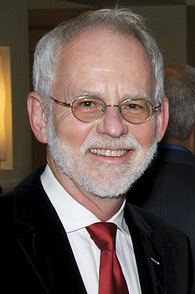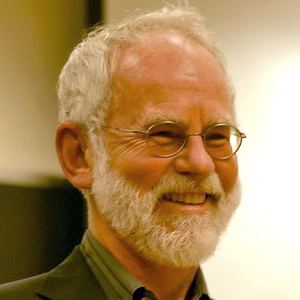Pea was born in Highland Park, Michigan on July 5, 1952. He received a dual major B.A. in philosophy and psychology from Michigan State University with an independently declared major in Cognition (1974) working with his mentor and friend Stephen Toulmin, and later, a D.Phil. in developmental psychology from Oxford University (1978), while studying as a Rhodes Scholar, working with his advisor Jerome Bruner. After studying child language and cognitive development from 1975 to 1980, his research concerns were attracted to understanding how innovations in computing and communications technologies can significantly influence learning, thinking, collaboration, and educational systems.
Pea is a key figure in the development of the learning sciences as a recognized field of research and graduate study. He founded and served as the first director of the first learning sciences doctoral program, at Northwestern University (1991), directing the NSF-funded field-building Center for Innovative Learning Technologies [6], and launching in 2002 the Learning Sciences and Technology Design (LSTD: http://ed.stanford.edu/academics/doctoral/lstd) program at Stanford University. In 2004–2005, Pea was President of the International Society for the Learning Sciences.
Pea was one of the first research scientists to build the Bank Street College Center for Children in Technology (1981–1986), the first social sciences center devoted to studying children's learning with technology. Later, recruited by John Seely Brown and Jim Greeno to contribute to the development of the intellectual agenda of the Palo Alto, California–based think-tank, The Institute for Research on Learning (1988–1991), he developed their K-12 learning technologies emphasis, with pioneering work on distributed intelligence [7], learning by multimedia authoring [8], and science learning with dynamic diagramming tools [9].
Research centers and industry advisor
In 1996, after a year at the Center for Advanced Studies in the Behavioral Sciences, Pea was recruited to SRI International, where he worked with colleagues to build a major national Center for Technology in Learning, until recruited to Stanford University in 2001. At Stanford, Pea co-founded Stanford's H-STAR Institute (Human Sciences and Technologies Advanced Research) with Byron Reeves, and is now H-STAR Institute Director. He is also co-director of the National Science Foundation-funded LIFE Center, one of six national Science of Learning Centers, whose studies seek to inform better bridging of the sciences of informal and formal learning.
In addition to serving as founding editor of the Cambridge University Press Series Learning in Doing: Cognitive, Social and Computational Perspectives since 1987, Pea was co-author of the 2000 National Academy Press volume How People Learn, Co-Editor of the 2007 Book Video Research in the Learning Sciences, and co-author of the 2010 US National Educational Technology Plan.
Pea served from 1999 to 2009 as a founding director for Teachscape, a company he co-founded with Mark Atkinson in 1999 that provides comprehensive K-12 teacher professional development services incorporating web-based video case studies of standards-based teaching and communities of learners. In addition to academic research and teaching, he advises a number of companies, non-profits, research centers, projects and federal agencies or foundations involved in learning with technologies. Company advisory roles include: Elucido Media Networks, Kno, and Kogeto. Pea is also a learning sciences advisor to HIV/AIDS education nonprofit TeachAIDS.
He is a Fellow of the National Academy of Education [10], Association for Psychological Science, The Center for Advanced Study in the Behavioral Sciences, and the American Educational Research Association.
Approximately 200 papers in academic journals, 4 co-edited volumesPea, R., Nass, C., Meheula, L., Rance, M., Kumar, A., Bamford, H., Nass, M., Simha, A., Stillerman, B., Yang, S., & Zhou, M. (2012). Media Use, Face-to-Face Communication, Media Multitasking and Social Well-Being among 8-12 Year Old Girls. Developmental Psychology, 48(2), 327-336. doi: 10.1037/a0027030White, T., & Pea, R. (2011). Distributed by design: On the promises and pitfalls of collaborative learning with multiple representations. The Journal of the Learning Sciences, 20(3), 1-59.Pea, R., & Martin, L. (2010). Values that occasion and guide mathematics in the family. In W. R. Penuel & K. O'Connor (Eds.), Learning Research as a Human Science (pp. 34–52), National Society for the Study of Education Yearbook, 109(1).Zahn. C., Pea, R., Hesse, F. W., & Rosen, J. (2010). Comparing simple and advanced video tools as supports for collaborative design processes. J. Learning Sciences, 19, 1-38.Pea, R., & Lindgren, R. (2008, Oct-Dec). Video collaboratories for research and education: an analysis of collaboration design patterns. IEEE Transactions on Learning Technologies, 1(4), 235-247.Derry, S., Pea, R.D., Barron, B., Engle, R.A., Erickson, F., Goldman, R., Hall, R., Koschmann, T., Lemke, J., Sherin, M.G. & Sherin, B.L. (2010). Conducting Video Research in the Learning Sciences: Guidance on Selection, Analysis, Technology, and Ethics. Journal of the Learning Sciences, 19(1), 3-53.Pea, R., with Christine L. Borgman (Chair), Hal Abelson, Lee Dirks, Roberta Johnson, Kenneth R. Koedinger, Marcia C. Linn, Clifford A. Lynch, Diana G. Oblinger, Katie Salen, Marshall S. Smith, Alex Szalay (2008, June 24). Fostering learning in the networked world—the cyberlearning opportunity and challenge: A 21st century agenda for the National Science Foundation (Report of the NSF Task Force on Cyberlearning). Arlington VA: NSF, 62pp. (Downloadable: http://www.nsf.gov/pubs/2008/nsf08204/nsf08204.pdf)Goldman, R., Pea, R. D., Barron, B. & Derry, S. (2007). (Eds.). Video research in the learning sciences. Mahwah, NJ: Lawrence Erlbaum Associates.Pea, R. D. (2006). Video-as-data and digital video manipulation techniques for transforming learning sciences research, education and other cultural practices. In J. Weiss, J. Nolan & P. Trifonas (Eds.), International Handbook of Virtual Learning Environments (pp. 1321–1393). Dordrecht: Kluwer Academic Publishing.Pea, R. D., & Maldonado, H. (2006). WILD for learning: Interacting through new computing devices anytime, anywhere. In K. Sawyer (Ed.), The Cambridge Handbook of the Learning Sciences (pp. 427–441). New York: Cambridge University Press.Bransford, J.D., Barron, B., Pea, R., Meltzoff, A., Kuhl, P. Bell, P., Stevens, R., Schwartz, D., Vye, N., Reeves, B., Roschelle, J. & Sabelli, N. (2006). Foundations and opportunities for an interdisciplinary science of learning. In K. Sawyer (Ed.), The Cambridge Handbook of the Learning Sciences (pp. 19–34). New York: Cambridge University Press.Pea, R. D. (2004). The social and technological dimensions of “scaffolding” and related theoretical concepts for learning, education and human activity. The Journal of the Learning Sciences, 13(3), 423-451.Pea, R., Mills, M., Rosen, J., Dauber, K., Effelsberg, W., & Hoffert. E. (2004, Jan-March). The DIVER™ Project: Interactive Digital Video Repurposing. IEEE Multimedia, 11(1), 54-61.Pea, R., Wulf, W., Elliot, S.W., & Darling, M. (2003, August). (Eds.). Planning for two transformations in education and learning technology (Committee on Improving Learning with Information Technology). Washington, DC: National Academy Press.Roschelle, J., & Pea, R. D. (2002). A walk on the WILD side: How wireless handhelds may change computer-supported collaborative learning (CSCL). The International Journal of Cognition and Technology, 1(1), 145-168.Bransford, J. D., Brown, A., & Cocking, R. (2000). (Eds.), How People Learn: Mind, Brain, Experience and School, Expanded Edition (incorporating both books below). Washington, DC: National Academy Press. (Co-author).Pea, R. D. (1999). New media communication forums for improving education research and practice. In E. C. Lagemann & L. S. Shulman (Eds.), Issues in education research: problems and possibilities (pp. 336–370). San Francisco, CA: Jossey Bass.Edelson, D. C., Gordin, D.N., & Pea, R. D. (1999). Addressing the challenges of inquiry-based learning through technology and curriculum design. Journal of the Learning Sciences, 8(3&4), 391-450.Pea, R.D., Gomez, L. M., Edelson, D.C., Fishman, B. J., Gordin, D. N., & O’Neill, D. K. (1997). Science education as a driver of cyberspace technology development. In K. C. Cohen (Ed.), Internet links for science education (pp. 189–220). New York, NY: Plenum Press.Gordin, D., & Pea, R. D. (1995). Prospects for scientific visualization as an educational technology. Journal of the Learning Sciences, 4(3), 249-279.Reiner, M., Pea, R. D., & Shulman, D. (1995). The impact of simulator-based instruction on the diagramming of the interaction of light and matter by introductory physics students. Journal of Science Education and Technology, 4 (3), 199-226.Pea, R. D. (1994). Seeing what we build together: Distributed multimedia learning environments for transformative communications. Journal of the Learning Sciences, 3(3), 285-299.Pea, R. D. (1993). Learning scientific concepts through material and social activities: Conversational analysis meets conceptual change. Educational Psychologist, 28(3), 265-277.Pea, R. D. (1993). Practices of distributed intelligence and designs for education. In G. Salomon (Ed.). Distributed cognitions (pp. 47–87). New York: Cambridge University Press.Pea, R. D. (1992). Augmenting the discourse of learning with computer-based learning environments. In E. de Corte, M. Linn, & L. Verschaffel (Eds.), Computer-based learning environments and problem-solving (NATO Series, subseries F: Computer and System Sciences). New York: Springer-Verlag GmbH (pp. 313–343).Pea, R. D., & Gomez, L. (1992). Distributed multimedia learning environments: Why and how? Interactive Learning Environments, 2(2), 73-109.Pea, R.D. (1991, July). Learning through multimedia. IEEE Computer Graphics and Applications, 11(4), 58-66.Mills, M. I., & Pea, R. D. (1989). Mind and media in dialog: Issues in multimedia composition. In K. Hooper & S. Ambron (Eds.), Full-Spectrum Learning (pp. 14–37). Cupertino, CA: Apple Computer, Inc.Hawkins, J., & Pea, R. D. (1987). Tools for bridging everyday and scientific thinking. Journal for Research in Science Teaching, 24(4), 291-307.Pea, R. D. (1987). Cognitive technologies for mathematics education. In A. Schoenfeld (Ed.), Cognitive science and mathematics education (pp. 89–122). Hillsdale, NJ: Erlbaum.Pea, R. D., & Sheingold, K. S. (1987). (Eds.). Mirrors of minds: Patterns of experience in educational computing. Norwood, NJ: Ablex. (In Computers and Cognition series, edited by John Black.) Co-authored four chapters. Translated and published in Russia and in China.Pea, R. D. (1987). Socializing the knowledge transfer problem. International Journal of Educational Research, 11, 639-663.Pea, R. D., & Kurland, D. M. (1987). Cognitive technologies for writing development. In L. Frase (Ed.), Review of Research in Education, Vol. 14 (pp. 277–326). Washington DC: AERA Press.Pea, R. D. (1986). Language-independent conceptual bugs in novice programming. Journal of Educational Computing Research, 2(1), 25-36.Pea, R. D. (1985). Beyond amplification: Using computers to reorganize human mental functioning. Educational Psychologist, 20, 167-182.Pea, R. D. (1985). Integrating human and computer intelligence. In E. L. Klein (Ed.), New directions for child development: No. 28, Children and computers (pp. 75–96). San Francisco: Jossey Bass.Pea, R. D., Kurland, D. M., & Hawkins, J. (1985). Logo and the development of thinking skills. In M. Chen & W. Paisley (Eds.), Children and microcomputers: Formative studies (pp. 193–212). Beverly Hills, CA: Sage.Pea, R. D., & Kurland, D. M. (1984). On the cognitive effects of learning computer programming. New Ideas in Psychology, 2, 137-168.Atkinson, M., Skorski, M., Pea, R.D., et al. “Computer implemented education system,” Patent filed June 30, 2000 (U.S. Serial # 09/609,204) for inventions underlying Teachscape.com, 2001. Awarded January 14, 2003 as US Patent #6,507,726)Pea, R.D., Mills, M., Hoffert, E., Rosen, J., and Dauber, K., “Methods and apparatus for interactive map-based analysis of digital video content” (U.S. Serial #10/331/776), filed Dec. 30, 2002. (Issued July 25, 2006 as US Patent #7,082,572 B2).Pea, R.D., Mills, M., Rosen, J. “Methods and apparatus for interactive point-of-view authoring of digital video content” (U.S. Serial #10/334/162), filed Dec. 30, 2002. Awarded October 26, 2010 as US Patent # 7,823,058.Patton, C., Roschelle, J., Pea, R.D., & Vahey, P. “Method and system for enabling and controlling communication typology, access to resources, and document flow in a distributed networking environment” (Originally filed as U.S. Serial #10/012/708 on Nov. 16, 2001; Revised Appl. No. 12/249/729, filed Oct. 10, 2008). Awarded February 28, 2012 as US Patent #8,127,039 B2.Pea, R.D., Mills, M., Hoffert, E., Rosen, J., and Dauber, K. “Methods and apparatus for interactive network sharing of digital video content” (U.S. Serial #10/331/775), filed Dec. 30, 2002. In review.

